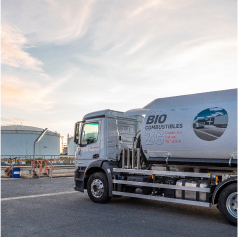Based on the source of the feedstock, they are classified as: first-generation biofuels (1G), from agricultural crops such as sugar cane, sugar beet or molasses; cereals such as wheat, barley or corn; or oils such as rapeseed or soybean. And second-generation (2G) biofuels, produced from organic waste, such as used cooking oils, agricultural or livestock waste or forest biomass, among others.
They help decarbonization
Their renewable nature means that they produce significantly lower net CO2 emissions during their life cycle than traditional fossil fuels (up to 90% less). This is very beneficial in sectors that are difficult to electrify, such as industry or heavy land, air, and sea transport.
They accelerate the energy transition
As they are chemically analogous to the fossil fuels used in current vehicle, truck, ship, and aircraft engines, they can partially or completely replace them without modifications. This means that they can be used now, accelerating the energy transition.
They promote the circular economy
When produced from organic waste, they give a second life to waste that would otherwise end up in landfills. This makes them a sustainable energy solution that promotes the circular economy.
They foster energy independence
They are an alternative to traditional fossil fuels, such as oil and gas, which makes it possible to diversify energy sources and, as a result, contribute to increasing the security of supply and the strategic energy independence of Spain and Europe.
They take advantage of technologies and facilities
Mature technologies already exist to produce them and, in some cases, existing industrial facilities can be reused, with certain modifications, to manufacture them.
Types of biofuels according to their application
Biofuels can replace traditional fuels both in their liquid state (as substitutes for diesel, gasoline, or kerosene) and in their gaseous state (replacing natural gas or liquefied petroleum gas, also known as LPG). They are therefore a sustainable ally in sectors that are difficult to decarbonize, such as heavy transport and industry.
Although their use in industry, aviation, or shipping is not yet widespread, biofuels are common in road transport. In Spain, biofuels have been used for years in diesel and gasoline engines, mixed with conventional fuels. The obligation in 2023 to incorporate biofuels in road transport is 10.5%, which will increase to 12% in 2026.


As part of our 2030 strategy, Positive Motion, we aim to lead 2G biofuel production in Spain and Portugal.
Discover our projects






